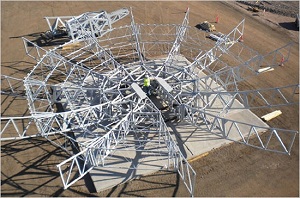Southwest partner with MaxQ to commercialize CPV for energy production
 Southwest Solar has partnered with MaxQ Technologies to use its closed loop cooling system to bring Southwest’s giant concentrated solar photovoltaic dish to the energy production market.
Southwest Solar has partnered with MaxQ Technologies to use its closed loop cooling system to bring Southwest’s giant concentrated solar photovoltaic dish to the energy production market.
Southwest has been working on two other applications for its solar dish, which is the largest in the country—a solar turbine and industrial heat and steam. In many ways those applications were simpler than energy production, said Southwest CEO Brad Forst. They used the heat that the dish generated.
The trickiest part of harnessing CPV’s immense potential is preventing solar cells from overheating.
“It’s a widely held consensus that CPV would be a real advance in the solar energy field if a couple of the technical issues with the technology could be properly managed,” Forst said.
CPV uses concentrating mirrors and glass and other material like magnifying glasses on solar photovoltaic arrays and can concentrate the sun’s rays by 1,200 times, Forst said.
“That concentration causes high, high temperatures,” he said. “And it’s those high temperatures that have caused CPV projects to fail.”
When Southwest began looking for ways to commercialize its technology for energy production, the Phoenix-based company’s principals looked for someone with cooling technology.
Then they found MaxQ, also based in Arizona.
“They were right here in our backyard, which we didn’t expect,” Forst said.
The company was building closed-loop, liquid-cooling systems for electric vehicles.
“Now we’re moving that technology over to the solar industry,” Forst said.
It works like a radiator in a traditional vehicle, he said. The solar cells abut to a cold plate and cool water flows through tubes underneath, moving the heat away from the solar cells and keeping them cool.
That will allow Southwest’s solar panels to outlast other CPV. Heat causes panels to die out quickly and lose efficiency.
Forst said Southwest and MaxQ are building a 50-kilowatt demonstration array that they will put into the field in June. They’ll spend the summer optimizing it and should be in low-rate production by the end of the year, Forst said.



